Harvest strawberries (Strawberry harvest will start around late April) – Strawberry harvest season
How to grow strawberries in chemical free cultivation. (Growing Japanese strawberries for beginners.) This time, I want to harvest the strawberries.
When we think of strawberry harvest time, we imagine early spring when it starts to get warm, but for strawberries grown in the field, the harvest time is around late April. The best time to harvest strawberries is around mid-May.
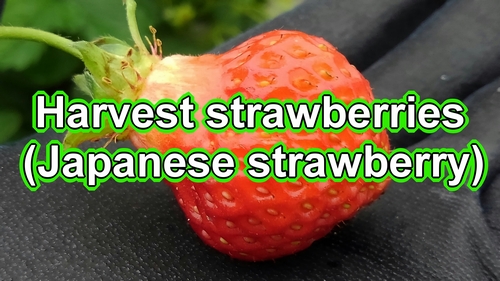
The variety of strawberries we are growing this season is “Houkou Wase". Houkou Wase is Japanese june bearing strawberries. An june bearing strawberry is a type of strawberry that is planted in the fall, survives through the winter, and starts to be harvested around spring of the next year.
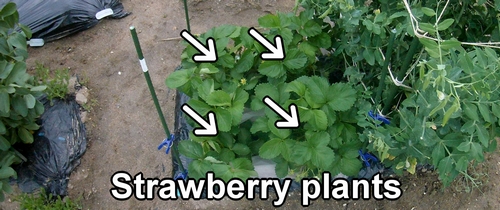
Houkou Wase strawberries are a variety suitable for home gardens, strong against diseases, and relatively easy to grow. I think these Japanese strawberries are easy to grow even for beginners in home gardening.
I grow strawberries in the field, and even with organic farming without pesticides, they have stayed healthy and grown well.
Soil preparation and planting strawberry seedlings (From late September to mid-October)
We started growing strawberries at the end of last September. For june bearing strawberries like “Houkou Wase", since we plant the seedlings in the fall, we prepare the soil during this time.
For growing strawberries with organic farming without pesticides, we use cow manure for compost and chicken manure for fertilizer. (Best compost for strawberries is cow manure, best organic fertilizer is chicken manure.)
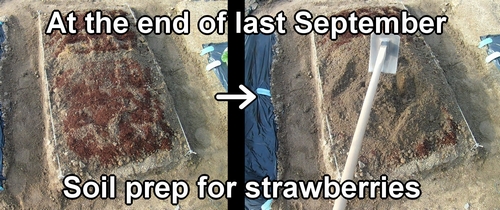
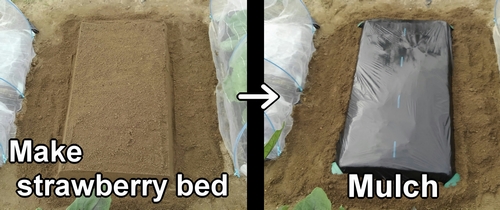
The strawberry seedlings were planted around mid-October. (Planting strawberries in the ground.)
Organic fertilizers like cow manure compost and chicken manure take about 3 weeks to a month to mix well with the soil. So, if you prepare the soil in late September, the strawberry seedlings can be planted around October.
The key to planting strawberry seedlings is the runners. If you plant the runners facing inside the bed, it makes it easier to manage the strawberries.
Strawberries tend to grow on the opposite side of the runners, so if you plant the runners facing inside, the strawberries will grow on the side of the path, making them easier to harvest.
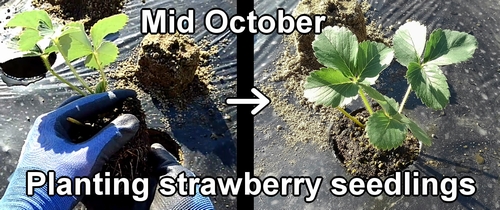
The harvest time for strawberries is around late April, so the time from planting to harvest is about 7 months. This is quite a long growing period for vegetables.
Preparing overwinter and dormancy for strawberries (around mid-November) – Strawberry care in winter
We prepared for overwintering strawberries in mid-November. For overwintering strawberries, we remove the mulch from the bed and expose the strawberries to the cold.
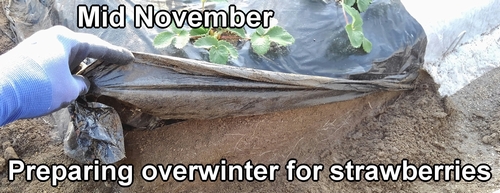
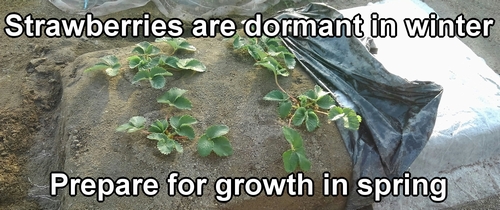
At this time, strawberries might have buds or flowers, but we remove them. We keep strawberry flowers starting in March. All buds and flowers that appear by the end of February are removed. (Early buds and flowers can hinder growth in the spring.)
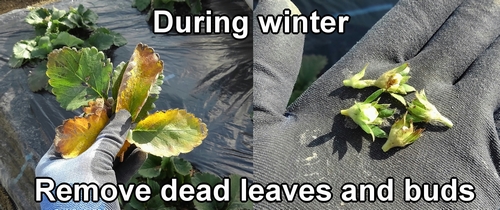
Strawberry fertilizing and restarting mulch (From early January to early February)
We did the strawberry fertilizing in early January, after the new year. We used chicken manure, which is an organic fertilizer, for the fertilizing.
The amount of fertilizer used is 10g (0.35 oz) per strawberry plant. Since we have 4 strawberry plants in one area, we used a total of 40g (1.4 oz) of fertilizer.
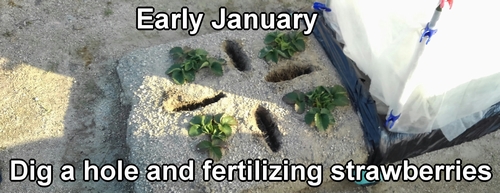
From early February, we restarted mulching the strawberry bed. This keeps the soil warm, raises the soil temperature, and helps the strawberries grow.
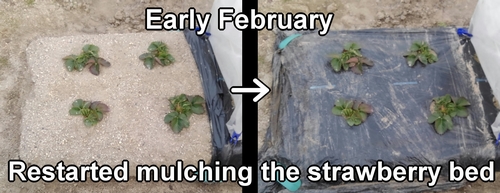
Making strawberry pillows with non-woven fabric (around mid-March) – Keeping strawberries off the ground
Around mid-March, we set up strawberry pillows around the area. (Keeping strawberries off the ground.) Strawberries are soft and can easily get damaged if they touch the ground, so this is a measure to prevent that.
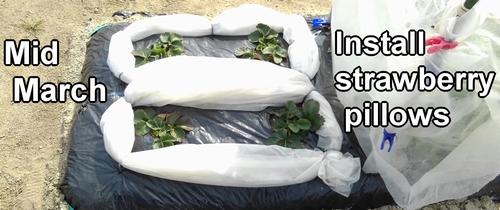
Strawberry farmers sometimes use straw mulch. For home garden strawberries, using non-woven fabric as a substitute for straw mulch is easy. (Non-woven fabric is easy to find at Home Depot or garden centers and has many uses.)
Cutting strawberry runners, strawberries self pollinating, and crow prevention (From mid-April to late April) – Spring care for strawberries
In mid-April, we managed the strawberry runners and did pollination. We removed the strawberry runners to focus nutrients on the fruit. Strawberry pollination was done using a brush.
For strawberries grown in the field, natural pollination will produce some fruit, but for better-shaped strawberries, it’s better to do hand pollination.
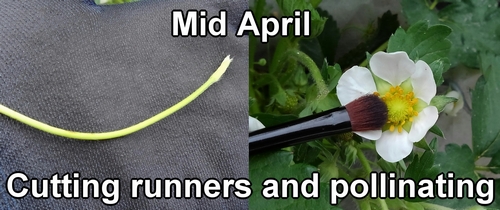
In late April, we took measures to prevent crows from getting the strawberries. (Protecting strawberries from birds.)
Field-grown strawberries are planted in the ground, so as they ripen, they can attract pests and animals. Therefore, we need to take measures to keep them safe.
This year, for crow prevention, we covered the strawberries with non-woven fabric to keep the fruit hidden.
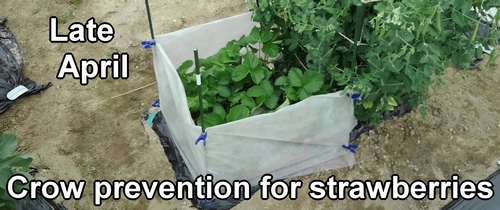
Harvest strawberries (from late April to late May) – Strawberry harvest season
This is the first strawberry harvest of the season, but we could only pick one berry. They are small this year. The strawberries are small, but they are well-colored, shiny, and look delicious.
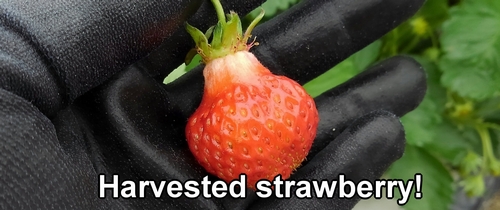
Strawberry harvesting has just begun. The strawberry harvest season will continue until the end of May, so I will pick the strawberries as they turn red. I can’t wait for the next harvest.
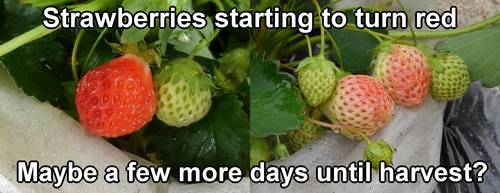
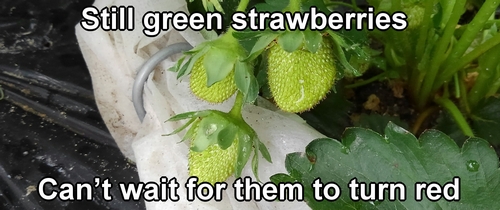
Related information on strawberry cultivation(Frequently Asked Questions for growing strawberries)
What strawberry varieties are good for open-field cultivation?
The strawberry variety good for open-field cultivation is “Houkou Wase (Japanese strawberry)". Houkou Wase is a strawberry with a juicy taste, and it is also strong against diseases, so it is good for growing in home gardens.
When is the season for open-field strawberries?
The season for open-field strawberries is from around mid-September to mid-May of the next year. (For june bearing strawberries, you plant in autumn and harvest in early summer the next year.)
For open-field strawberries, soil preparation starts around mid-September, and planting is around early October. After overwinter, you can start harvesting from around late April of the next year.
What fertilizer is good for open-field strawberry cultivation?
For strawberries planted in the ground, in organic farming, cow manure compost and chicken manure are often used as starter fertilizer. Cow manure compost is used to balance the soil’s air flow and water retention. Since it is compost, it has less nutrients.
Chicken manure is an organic fertilizer that contains a good balance of nutrients (like nitrogen, phosphorus, and potassium) needed for strawberry growth. When you think of growing strawberries, you might imagine using many different fertilizers, but you can actually grow them with a surprisingly simple combination.
When should you add extra fertilizer (side dressing) for open-field strawberries? What kind of extra fertilizer should you use?
For open-field strawberries (june bearing strawberries), you add extra fertilizer (side dressing) around early January of the new year. In winter, it takes about a month for the fertilizer to start working.
Open-field strawberries start to grow and produce fruit around mid-February, so if you add extra fertilizer in early January, it will start to work just in time.
For side dressing for strawberries, chicken manure is recommended. Chicken manure contains important nutrients like nitrogen, phosphorus, and potassium that are needed for strawberry cultivation. A good amount to use is about 10g (0.35 oz) of chicken manure per strawberry plant.
Following is the video for how-to. English subtitles are available.
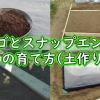

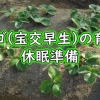
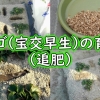
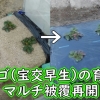


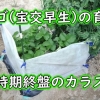
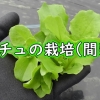
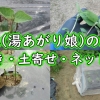

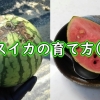
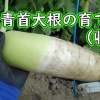
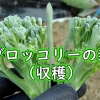




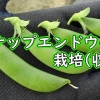

ディスカッション
コメント一覧
まだ、コメントがありません